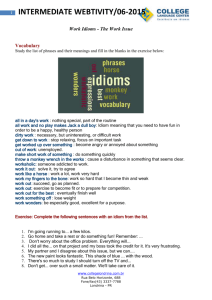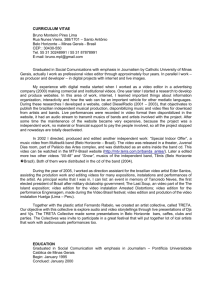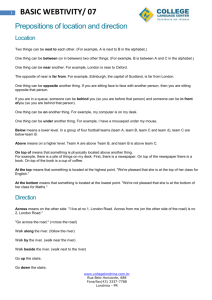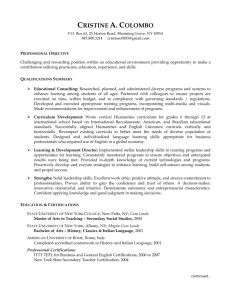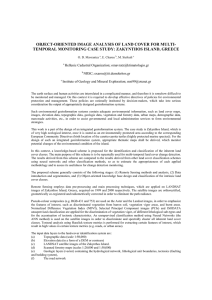MULTI-TEMPORAL OBJECT-ORIENTED CLASSIFICATIONS AND ANALYSIS OF MINAS GERAIS STATE) QUICKBIRD
advertisement
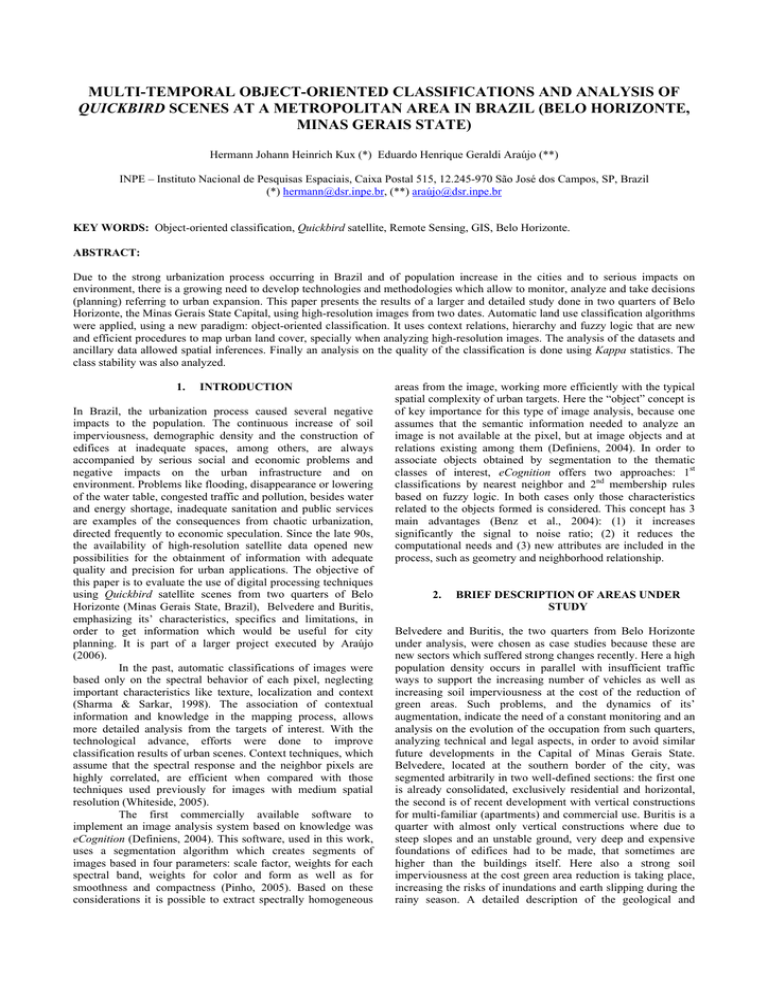
MULTI-TEMPORAL OBJECT-ORIENTED CLASSIFICATIONS AND ANALYSIS OF QUICKBIRD SCENES AT A METROPOLITAN AREA IN BRAZIL (BELO HORIZONTE, MINAS GERAIS STATE) Hermann Johann Heinrich Kux (*) Eduardo Henrique Geraldi Araújo (**) INPE – Instituto Nacional de Pesquisas Espaciais, Caixa Postal 515, 12.245-970 São José dos Campos, SP, Brazil (*) hermann@dsr.inpe.br, (**) araújo@dsr.inpe.br KEY WORDS: Object-oriented classification, Quickbird satellite, Remote Sensing, GIS, Belo Horizonte. ABSTRACT: Due to the strong urbanization process occurring in Brazil and of population increase in the cities and to serious impacts on environment, there is a growing need to develop technologies and methodologies which allow to monitor, analyze and take decisions (planning) referring to urban expansion. This paper presents the results of a larger and detailed study done in two quarters of Belo Horizonte, the Minas Gerais State Capital, using high-resolution images from two dates. Automatic land use classification algorithms were applied, using a new paradigm: object-oriented classification. It uses context relations, hierarchy and fuzzy logic that are new and efficient procedures to map urban land cover, specially when analyzing high-resolution images. The analysis of the datasets and ancillary data allowed spatial inferences. Finally an analysis on the quality of the classification is done using Kappa statistics. The class stability was also analyzed. 1. INTRODUCTION In Brazil, the urbanization process caused several negative impacts to the population. The continuous increase of soil imperviousness, demographic density and the construction of edifices at inadequate spaces, among others, are always accompanied by serious social and economic problems and negative impacts on the urban infrastructure and on environment. Problems like flooding, disappearance or lowering of the water table, congested traffic and pollution, besides water and energy shortage, inadequate sanitation and public services are examples of the consequences from chaotic urbanization, directed frequently to economic speculation. Since the late 90s, the availability of high-resolution satellite data opened new possibilities for the obtainment of information with adequate quality and precision for urban applications. The objective of this paper is to evaluate the use of digital processing techniques using Quickbird satellite scenes from two quarters of Belo Horizonte (Minas Gerais State, Brazil), Belvedere and Buritis, emphasizing its’ characteristics, specifics and limitations, in order to get information which would be useful for city planning. It is part of a larger project executed by Araújo (2006). In the past, automatic classifications of images were based only on the spectral behavior of each pixel, neglecting important characteristics like texture, localization and context (Sharma & Sarkar, 1998). The association of contextual information and knowledge in the mapping process, allows more detailed analysis from the targets of interest. With the technological advance, efforts were done to improve classification results of urban scenes. Context techniques, which assume that the spectral response and the neighbor pixels are highly correlated, are efficient when compared with those techniques used previously for images with medium spatial resolution (Whiteside, 2005). The first commercially available software to implement an image analysis system based on knowledge was eCognition (Definiens, 2004). This software, used in this work, uses a segmentation algorithm which creates segments of images based in four parameters: scale factor, weights for each spectral band, weights for color and form as well as for smoothness and compactness (Pinho, 2005). Based on these considerations it is possible to extract spectrally homogeneous areas from the image, working more efficiently with the typical spatial complexity of urban targets. Here the “object” concept is of key importance for this type of image analysis, because one assumes that the semantic information needed to analyze an image is not available at the pixel, but at image objects and at relations existing among them (Definiens, 2004). In order to associate objects obtained by segmentation to the thematic classes of interest, eCognition offers two approaches: 1st classifications by nearest neighbor and 2nd membership rules based on fuzzy logic. In both cases only those characteristics related to the objects formed is considered. This concept has 3 main advantages (Benz et al., 2004): (1) it increases significantly the signal to noise ratio; (2) it reduces the computational needs and (3) new attributes are included in the process, such as geometry and neighborhood relationship. 2. BRIEF DESCRIPTION OF AREAS UNDER STUDY Belvedere and Buritis, the two quarters from Belo Horizonte under analysis, were chosen as case studies because these are new sectors which suffered strong changes recently. Here a high population density occurs in parallel with insufficient traffic ways to support the increasing number of vehicles as well as increasing soil imperviousness at the cost of the reduction of green areas. Such problems, and the dynamics of its’ augmentation, indicate the need of a constant monitoring and an analysis on the evolution of the occupation from such quarters, analyzing technical and legal aspects, in order to avoid similar future developments in the Capital of Minas Gerais State. Belvedere, located at the southern border of the city, was segmented arbitrarily in two well-defined sections: the first one is already consolidated, exclusively residential and horizontal, the second is of recent development with vertical constructions for multi-familiar (apartments) and commercial use. Buritis is a quarter with almost only vertical constructions where due to steep slopes and an unstable ground, very deep and expensive foundations of edifices had to be made, that sometimes are higher than the buildings itself. Here also a strong soil imperviousness at the cost green area reduction is taking place, increasing the risks of inundations and earth slipping during the rainy season. A detailed description of the geological and geotechnical characteristics of both quarters is found in Silva et al. (1995), Carvalho (1999) and Araújo (2006). 3. MATERIALS AND METHODS Two Quickbird scenes (from 2002 and 2004), type ORStandard2A were ortho-rectified and analyzed, as well as aerial photographs of an aero-photogrammetric mission from 1989. The satellite images were delivered by INTERSAT Ltda. and the aerial photographs by PRODABEL, the municipal planning and information agency. Furthermore several ancillary data, such as maps, reports and urban cadastre were used, listed in Araújo (2006). Among the software packages used, the most important were: Autocad Map 2000 to edit files containing vectors; SPRING to generate a DEM, editing vector and matrix data and to reunite all results for the elaboration of spatial inferences; ENVI to test the ortho-rectification, fusion, edition in vector data, generation of slope and steepness data; ERDAS to test ortho-rectification, eCognition 4.0 for object oriented classification and PCI for testing and definitive orthorectification of both satellite images. The methodological procedures followed in the complete study (Araújo, 2006) are summarized in the flow diagram shown at Fig. 1. In this paper however, due to lack of space, we concentrate in the phases of “Classification” and “Analysis of Results”. 3.1 Definition of classes Table 1 presents the classes defined from the visual interpretation of the satellite images and ortho-photos, with the support of field survey. Using elements color, texture, form, size, shadow, height, standard and context, interpretation keys were elaborated. This evidenced the limitation of an automatic classification. 3.2 Segmentation After several tests to attend the interests and demands of the classification, and because it is a multi-resolution segmentation, we concluded that 3 segmentation levels were needed: 1st to classify the land cover; 2nd which results in larger objects and the 3rd that includes smaller objects. Since any segmentation interferes in the next one, it is advisable that the first one is that one where the classification will be used for the analysis (Definiens, 2004). Following this premise, the first segmentation done and called “level 2” objectified the separation of different objects of interest in the urban environment. Since in this environment there is a great number of targets with different sizes, we looked for those which are most important in this study: the constructions. In this segmentation we prioritized the color and smoothness instead of form and compactness, in order to reach objects with smooth linear borders like houses and buildings. At the second segmentation, called “level 3”, those parameters were used to prioritize the form and larger objects, such as the objects similar to the polygons of the thematic data from the urban cadastre. As for “level 1”, the third segmentation done, the scale threshold was reduced to obtain very small objects, i.e. smaller than those of interest to create new classification rules. 3.3 Hierarchy among classes In this type of classification the hierarchy among classes allows to estimate the interclass relationship and its groups. In this stage a net was developed where the easier distinguishable objects have a higher position in relation to those with larger confusion. The objects were divided, a priori, as belonging or not to classes of major easiness to separation. The hierarchy was developed as a consequence of non-association from objects to higher classes. This was done so that those classes presenting major confusion are left to the lower levels of hierarchy, reducing the classification error and allowing understanding the limitation of the process. The impossibility to distinguish some classes was one of the reasons why some of them were grouped. The hierarchical determination was changed during different tests, which were done to understand the best possible relation among the groups of targets (Fig. 2). 3.4 Membership rules Here one delimits the attributes which will be used by the classifier. We choose to work with the membership functions instead of a classification of nearest neighbor. The selection of attributes used to discriminate each class was done initially by the “Feature View”, opened at a window from e-Cognition 4.0 software. After the previous attribute definition, we used class histograms, generated by samples collected during field survey, to define the fuzzy functions and its limits for each class. 3.5 Evaluation of classification results In order to evaluate the result of classifications, a confusion matrix was generated wherefrom a series of relevant information is extracted to evaluate the quality of this procedure, such as the Kappa index. The evaluation from the exactness of classification is done initially by visual analysis. Afterwards 30 samples per class were collected from Belvedere and Buritis for the 2002 scene and 50 samples for the 2004 scene. These samples were collected using as units the polygons generated for the level 2 of segmentation, which reflects the ground truth. They were chosen using the satellite images, ortho-aerial photos and field survey information. The samples were then compared with the results of classification and only those classes of interest were selected for the statistic calculations. The Kappa statistics is then generated and, due to space limitations, we present here just the overall Kappa value for each classification (Table 2). The class stability was generated, visualized and analyzed directly in the e-Cognition package. 4. DISCUSSION OF RESULTS The results obtained by the thematic classification (Figure 3) from both test sites Buritis and Belvedere (2002 and 2004) shows the growth of impervious surfaces. This can be observed by the increase of objects classified as “Gray cover”. The calculated Kappa values (Table 1) are considered as “very good” to “excellent” according to a table developed by Landis and Koch (1977). The improvement of the Kappa index from 2002 to 2004 at both test-sites is due to the classification procedure. Initially we classified both scenes of 2004, because they cover a larger and more complex area, and afterwards the same structure and rules were adapted and applied to the 2002 scenes. This procedure was not entirely satisfactory since the Kappa index for 2002 was lower than that of 2004. The evaluation of the object stability was also satisfactory for the continuation of this study. A visual analysis of the stability map made showed a high stability for almost all objects. Based on the analysis of land cover classes from both datasets, the following increments and losses were calculated (Table 3). The “Vegetation” considered in the calculation includes both classes Arboreal vegetation and Grass, while “Impervious areas” includes all classes except “Shadow”, “Bare soil” and “Vegetation”. The reduction of “Bare soil” (i.e. lots prepared for construction) at both quarters is an indication for the dynamics of constructions in the timeframe considered. As for the class “Shadow” it was not always very clear which class is “hidden” in it, but geometric shadows normally indicate multi-storey constructions and more seldom an isolated tree. As for the two Cover types (white and gray) there are only subtle differences among them referring to the construction materials: cement/concrete, metal roofs (mainly aluminum) and asbestos. As a general rule, white cover types present a higher brightness and are in a more favorable angle to the sensor, as far as reflection is concerned, while gray cover types with the same construction material as white covers can be older and sometimes covered by a moss-like vegetation, which changes its color along the dry and rainy season. The comparison of Impervious against Vegetation covered areas for the timeframe 2002 and 2004 must be considered within the limitations of coverage from the two Quickbird scenes available for the study. Since the coverage of both scenes did not match exactly, and in order to have the same area for an useful comparison of increments, we considered in Table 2 only the area of both quarters covered by the satellite data. During the field survey however we realized that the area which was not covered by both scenes from Buritis was suffering a strong deforestation (i.e. increasing class “Bare soil” and later on “Impervious areas” due to constructions), certainly increasing strongly the figure of vegetation loss for 2004. As for Belvedere the vegetation loss is not so dramatic, because the area effectively used for comparison had a relatively minor change of Total Vegetation for the timeframe considered, as depicted from Table 2. • The methodological procedures used in this work proved the effectiveness of the object-oriented classification approach to map urban land cover, allowing spatial inferences about this environment, analyzed in detail by Araújo (2006). 5. CONCLUSIONS Sharma, K.; Sarkar, A.,1998. A modified contextual classification technique for remote sensing data. Photogrammetric Engineering & Remote Sensing, vol. 64 (4), pp. 273-280. Referring to the methodology used in this paper for objectoriented classification it is concluded that: • Using the urban cadastre as a thematic layer in the segmentation process contributed to distinguish among streets and blocks of the areas under study. This was of fundamental importance to map the class “Asphalt”, whose precision was high for the satellite scenes classified. • Texture was of fundamental importance to discriminate between Arboreal Vegetation and Grass and it became possible solely when using context rules and hierarchy obtained by the different levels generated. • The hierarchy established was used in all four classifications performed. The possibility to use the same hierarchical net, or with few adaptations in similar works, improves the mapping process. • The membership rules established for both the same sensor system and area under study must be changed so that there is an adaptation to the characteristics of the images used. The limits of values for each rule are variable in different images. The membership functions are more efficient and faster to use in the classification than the nearest neighbor procedure. • Several types of cover materials (such as asbestos, concrete, cement, etc) were considered as just one thematic class because otherwise confusion on the separation would not allow a reliable discrimination. 6. REFERENCES Araújo, E.H.G., Análise multi-temporal de cenas do satélite Quickbird usando um novo paradigma de classificação de imagens e inferências espaciais: estudo de caso Belo Horizonte, MG. São José dos Campos, 159 p. Dissertação (Mestrado em Sensoriamento Remoto) – INPE, 2006. Benz, U.C.; Hofmann, P.; Willhauck, G.; Lingenfelder, I.; Heynen, M.,2004. Multi-resolution, object-oriented fuzzy analysis of remote sensing data for GIS-ready information. ISPRS Journal of Photogrammetry & Remote Sensing, vol. 58, Nr. 3-4, pp. 239-258. Carvalho, E.T., 1999. Geologia Urbana para Todos: uma visão de Belo Horizonte. Belo Horizonte, MG, 176 p. Definiens, eCognition, 2004. User Guide 4.0, Germany, 486 p. Landis, J. R.; Koch, G. G., 1977. The measurement of observer agreement for categorical data. Biometrics, vol. 33 (1), pp. 159174. Pinho, C.M.D.; Análise orientada a objetos de imagens de satélite de alta resolução espacial aplicada à classificação de cobertura do solo no espaço intra-urbano: o caso de São José dos Campos - SP. São José dos Campos, 179 p., Dissertação (Mestrado em Sensoriamento Remoto) – INPE, 2005. Silva, A.B.; Carvalho, E.T.; Fantinel, L.M.; Romano, A.W.; Viana, C.S.,1995. Mapa Geológico de Belo Horizonte. Belo Horizonte, MG, PBH, (Escala 1:25.000). Whiteside, T.; Ahmad, W., 2005. A comparison of objectoriented and pixel-based classification methods for mapping land cover in Northern Australia. Proceedings of SSC2005 Spatial Intelligence, Innovation and Praxis: the National Biennial Conference of the Spatial Sciences Institute, pp. 12251231. Acknowledgements: The help of the following institutions and companies is acknowledged: PRODABEL, (Planning Institute of Belo Horizonte Municipality) for the delivery of several maps and aerial photographs, UFMG, Instituto de Geociências, for the geological map of Belo Horizonte, INTERSAT – Imagens de Satélite Ltda., for both Quickbird scenes, INPE for the funding of field survey, several facilities and a working place. Name of class Arboreal vegetation Grass Ceramics tile Bare soil Asphalt Shadow Swimming pool Flare Gray cover White cover Table 1 – Definition of classes considered Descriptive Characteristics Strong response in the IR band. Texture due to different heights of trees (shadow). Easily distinguishable from other classes. Also strong response in the IR band. Uniform. Texture is smoother than Arboreal vegetation. Simple square geometry, orange-like color with large tone variation. Smooth texture. Easily identifiable visually. Earth works, prepared for constructions. No standard. Irregular forms, variable texture and random localization. Used from urban cadastre to delimit streets, avenues and roads. Linear and straight forms Low brightness. Close to high buildings and arboreal vegetation. Strong response in the blue and sometimes in the green band. Well defined. Roofs, mainly of new asbestos and cement. Quantization level close to 2048. Cover of large buildings. Presents many variations. High brightness. No discernment of probable constituting materials. Table 2 - Overall Kappa index for both test-sites at different dates Test-site / Date Overall Kappa Belvedere 2002 0,75 Belvedere 2004 0,86 Buritis 2002 0,77 Buritis 2004 0,84 Table 3 - Area of land cover classes from Buritis and Belvedere in 2002 and 2004 Areas of classes of land cover (in m2) Thematic Classes Buritis 2002 Buritis 2004 Belvedere 2002 Belvedere 2004 Asphalt 122242,68 134768,53 169990,93 166739,05 White cover 45323,28 52157,16 52663,32 30020,40 Gray cover 412826,79 444673,83 203189,77 274347,02 Flare 2331,36 631,80 93,60 611,64 Swimming pool 471,60 626,76 2994,12 4590,00 Shadow 58006,08 92256,48 42384,60 52450,56 Bare soil 125866,09 88027,56 242991,73 182394,73 Ceramics tile 9463,32 4576,32 87817,32 99083,88 Vegetation (total) 981459,79 938670,19 365222,18 360869,06 Impervious areas (total) 589856,07 636175,84 513661,34 570190,35 Quickbird image 2002 Analysis of: - Requirements; - Relevance; - Membership DEFINITION OF AREA STUDIED Quickbird image 2004 DEM GEOMETRIC CORRECTION Contour lines D-GPS (GCP) Ortho-rectification Ortho images Data preparation Definition of classes Segmentation Hierarchy Membership rules Evaluation CLASSIFICATION Edited Cadastre Land cover Urban growth SPATIAL INFERENCES Ancillary data Geological risks ANALYSIS OF RESULTS Information acquired Information generated CONCLUSIONS Fig. 1 – Flow diagram of methodological procedures. LEVEL 3 LEVEL 2 Blocks Streets Outside area under study Vegetation Grass No vegetation Shadow Arboreal No Shadow High brightness White cover Flare Bare soil Asphalt No High brightness Red objects No Red objects Ceramics tile Gray cover LEVEL 1 Blue objects (L1) Blue objects Swimming pool No Blue Objects (L1) Classes considered Ceramics tile (L1) Fig. 2 – Hierarchical net. Auxiliary classes BELVEDERE 2004 – LAND COVER BELVEDERE 2002 – LAND COVER BURITIS 2004 – LAND COVER BURITIS 2002 – LAND COVER Fig. 3 – Image classification of Belvedere and Buritis quarters – 2002 and 2004
